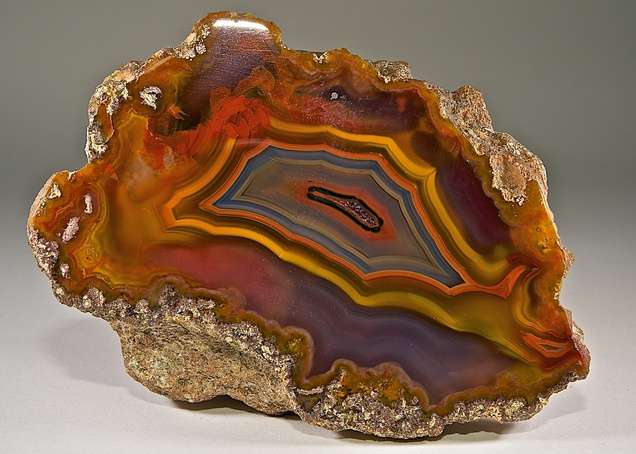
Appearance
An agate’s typical appearance is described as curved, angular layers or banding, but it can also resemble moss or a plume. Because of their microcrystalline structure, bands can have a variety of translucency and an extremely tiny grain or fibrous structure. Sometimes agate is colored.
Geographical Distribution
Agate can occur in a range of geological environments and is found around the world. Agate deposits are found in several major places, including Germany, Uruguay, Russia, China, Brazil, Mexico, India, Australia, and Madagascar. There are agate deposits in Xinjiang, Gansu, and Inner Mongolia, among other parts of China.
History
The Greeks named a river in Sicily Achates, which is whence agate gets its name. As early as 300 B.C., large amounts of agate were found in this particular river. Agate deposits were found along the Nahe River in Germany during the Gallic Wars, which took place under Julius Caesar’s region.
Metaphysical Properties
It changes the energy that is negative into positive energy. Agate is said to increase mental clarity, focus, perception, and analytical skills. It is a relaxing and peaceful gemstone that helps to improve relationships and soothes inner anger and anxiety.

Chemical Composition
Agate is a form of chalcedony, a member of the quartz family of minerals. Agate’s distinctive color and patterns are caused by minute amounts of impurities and trace elements, which make up the majority of its chemical composition (SiO2). Among the most typical contaminants discovered in agate are:
- The impurity iron oxide (Fe2O3) is responsible for the red, orange, and yellow hues of agate.
- The impurity manganese oxide (MnO2) is responsible for the black and brown hues of agate.
- The impurity aluminum oxide (Al2O3) can impart blue, green, or purple hues to agate.
- Calcium carbonate (CaCO3) is an impurity that can give agate white bands or layers.
Additional trace elements: Agate’s color and other physical characteristics may be impacted by the presence of trace levels of additional metals like copper, nickel, and cobalt.
Types
Lace Agate Crystal
Different varieties of lace agate exhibit bands, swirls, and concentric circles that combine to form complex patterns that mimic lace. Additionally, these kinds can have a huge range of color combinations.
Turritella
The gaps and cavities that this stone forms inside the fossil are where it gets its name. Turritella snail shells have a tiny unicorn horn-like form. And the Turritells snail fossil is preserved when this salacious mineraloid fills in the empty places.
Carnelian Agate Gemstone
Warm red and orange colors are indicative of carnelian agate crystal. This kind of chalcedony has less obvious banding, but it also seems to be more uniform.
Coldwater
The name “Coldwater stone” refers to the stone’s conspicuous absence of vivid coloring. This stone’s predominant hues range from cloud-white to light blue.
Greek Achate
This term refers to the Greek name of the Dirillo River in Sicily, Italy, and the initial discovery of this semiprecious mineraloid. Constricted lines trend towards the center, and colors vary from light to dark gray, red, tan, and blue.
Fire Agate
The iridescent color of fire agate is similar to that of mother-of-pearl. Actually, there are similarities between the two. It does, however, continue to have a black background with accents of bright green, red, yellow, and blue.
Brazilian
Most of the semiprecious stone found in Brazil is from the southern region. In addition to its enormous size, this stone is well-known for its geodetic and circular design. Of course, it comes in a range of hues, including reddish-brown, white, blue, and gray.
Polyhedroid
A unique type of agate known as polyhedroid agate is found in distinct geometric shapes such as triangles and quadrilaterals formed by straight lines. However, as it is an amorphous mineraloid rather than a mineral, these shapes do not represent the “cleavage” quality of a crystal.
Botswana Agate Gemstone
The colors of Botswana agate include Prussian blue, eggplant, mauve, and gray. Furthermore, it appears that the majority of Botswana agate varieties occur globally with this distinctive banding.
Plume
The plume stones come in a variety of hues, including as blue, green, red, purple, and even neutral shades. However, a single specimen can include the whole color spectrum.
Moss Agate Crystal
The forest-green and blue-green tones give rise to the names of the several moss agate varieties. The designs are colored a dark green, as the name implies. It looks like moss on a rock.
Uses
Agate is utilized in the following ways:
- Jewelry: Because of its exquisite patterns and colors, agate is frequently used as a gemstone in jewelry. It is frequently used in necklaces, bracelets, and earrings after being cut and polished into cabochons, beads, and pendants.
- Decorative items: Because of its inherent beauty and toughness, agate is often utilized in decorative items like coasters, bookends, and vases.
- Because of its beauty and resilience, it is frequently used as a gemstone in jewelry and ornamental items. Because of its hardness and resilience to wear and tear, agate is also widely employed in industry as grinding media and cutting tools.
Table





